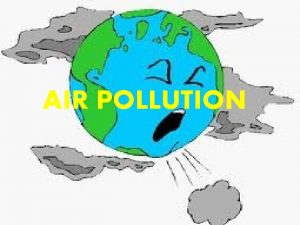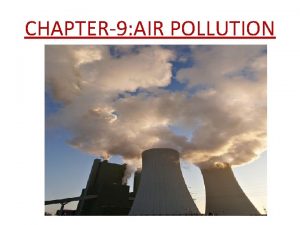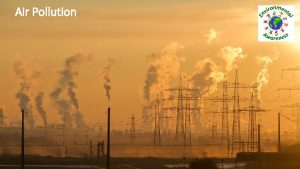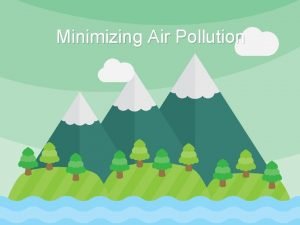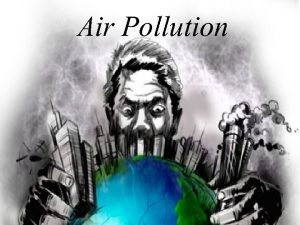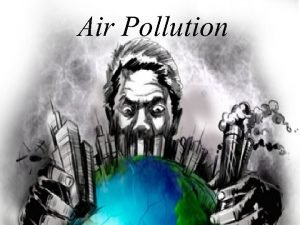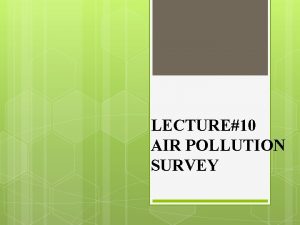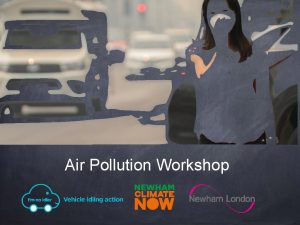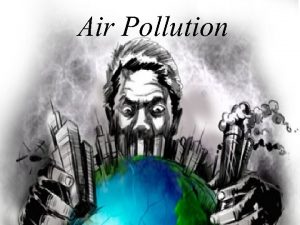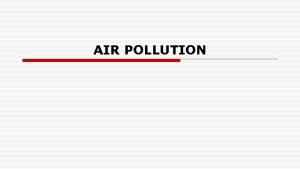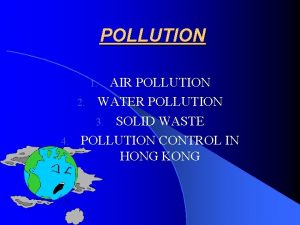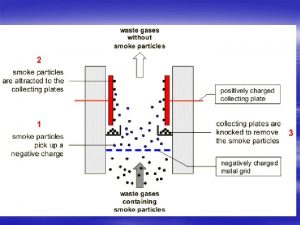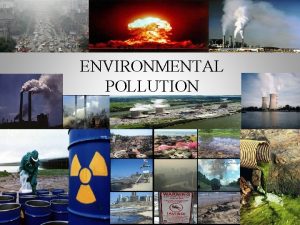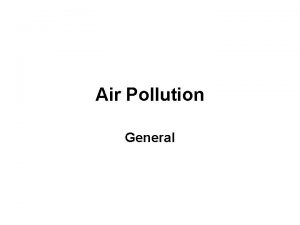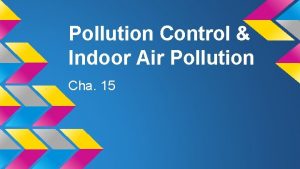AIR POLLUTION Air Pollution Air pollution is the


























- Slides: 26

AIR POLLUTION

Air Pollution Air pollution is the introduction of chemicals, particulate matter or biological materials that cause harm or discomfort to humans or other living organisms, or cause damage to the natural environment or atmosphere.

Air Pollution • Stratospheric ozone depletion due to air pollution has long been recognized as a threat to human health as well as to the Earth's ecosystems.

What is Pollution ? • All living organisms depend upon balanced environment for growth, development, and reproduction.

What is Pollution ? • The balance of the environment may be disturbed by the entrance of some harmful and some unwanted components in the environment. • These unwanted and harmful components make the environment polluted. These is called Pollution.

Thus, any undesirable change of the physical, chemical or biological characteristics of the environment, which is harmful to man directly or indirect through animals, plants, industrial units or raw materials, is called Pollution.

The substance which contaminate air, water and soil are called pollutants. These pollutants can be classified into two groups: 1. Biodegradable pollutants 2. Non-biodegradable pollutants.

HOW DOES AIR GET POLLUTED? • • The substances which contaminate the air are called Air Pollutants. Sometimes, such substances may come from natural sources like smoke and dust arising from forest fires or volcanic eruptions.

• Pollutants are also added to the atmosphere by human activities. • The sources of air pollutants are factories power plants, automobile exhausts and burning of firewood and dung cakes.


Pictures related with Air Pollution



WATER POLLUTION

Water pollution • Water pollution is the contamination of water bodies (e. g. lakes, rivers, oceans and groundwater). • Occurs when pollutants are discharged directly or indirectly into water bodies without adequate treatment to remove harmful compounds.

• Water pollution affects plants and organisms living in these bodies of water. • In almost all cases the effect is damaging not only to individual species and populations, but also to the natural biological communities.

• Water pollution is a major global problem which requires ongoing evaluation and revision of water resource policy at all levels. • It has been suggested that it is the leading worldwide cause of deaths and diseases, and that it accounts for the deaths of more than 14, 000 people daily.




Case Study : The Taj Mahal • Over the past 2 decades, India’s most famous tourist attraction, Taj Mahal located in Agra has become a matter of concern. • Experts have warned that pollutants in air are discolouring its white marble. • So, it is not only living organisms that get affected by polluted air but non-living things like buildings, monuments and statues also get affected.

Case Study : The Taj Mahal • The industries located in and around Agra like rubber processing, automobile, chemicals and especially the Mathura oil refinery, have been responsible for producing pollutants like sulphur dioxide and nitrogen dioxide. • These gases react with the water vapour present in the atmosphere to form sulphuric acid and nitric acid. The acids drop down with rain, making the rain acidic. This is called acid rain. Acid rain corrodes the marble of the monument.

• • The phenomenon is also called “Marble cancer”. Suspended particulate matter, such as the soot particles emitted by Mathura oil refinery, has contributed towards yellowing of the marble.



 Chapter 12 section 1
Chapter 12 section 1 Chapter 12 air section 1 what causes air pollution
Chapter 12 air section 1 what causes air pollution Air higroskopis adalah
Air higroskopis adalah Khi nào hổ con có thể sống độc lập
Khi nào hổ con có thể sống độc lập Các châu lục và đại dương trên thế giới
Các châu lục và đại dương trên thế giới Dạng đột biến một nhiễm là
Dạng đột biến một nhiễm là Bổ thể
Bổ thể Nguyên nhân của sự mỏi cơ sinh 8
Nguyên nhân của sự mỏi cơ sinh 8 độ dài liên kết
độ dài liên kết Thiếu nhi thế giới liên hoan
Thiếu nhi thế giới liên hoan Vẽ hình chiếu vuông góc của vật thể sau
Vẽ hình chiếu vuông góc của vật thể sau Chúa yêu trần thế
Chúa yêu trần thế điện thế nghỉ
điện thế nghỉ Một số thể thơ truyền thống
Một số thể thơ truyền thống Sơ đồ cơ thể người
Sơ đồ cơ thể người Công của trọng lực
Công của trọng lực Bảng số nguyên tố
Bảng số nguyên tố Tỉ lệ cơ thể trẻ em
Tỉ lệ cơ thể trẻ em đặc điểm cơ thể của người tối cổ
đặc điểm cơ thể của người tối cổ Các châu lục và đại dương trên thế giới
Các châu lục và đại dương trên thế giới ưu thế lai là gì
ưu thế lai là gì Thẻ vin
Thẻ vin Kể tên các môn thể thao
Kể tên các môn thể thao Tư thế ngồi viết
Tư thế ngồi viết Cái miệng nó xinh thế chỉ nói điều hay thôi
Cái miệng nó xinh thế chỉ nói điều hay thôi Hình ảnh bộ gõ cơ thể búng tay
Hình ảnh bộ gõ cơ thể búng tay Cách giải mật thư tọa độ
Cách giải mật thư tọa độ




























